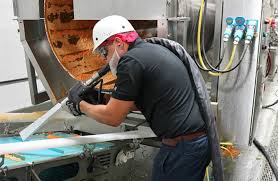In today’s energy storage landscape, 200ah battery has gained significant traction for their robust performance and versatility. These batteries are particularly suited for applications like solar power systems, recreational vehicles (RVs), and marine use. The “200Ah” rating indicates the battery’s capacity to deliver 200 amperes of current for one hour before recharging, making them ideal for scenarios requiring sustained power. Various types of 200Ah batteries are available, including lead-acid, lithium-ion, and AGM (Absorbent Glass Mat) batteries. Each type offers distinct advantages, such as longer cycle life or better efficiency, catering to different needs and preferences.
Understanding 200-Ah Battery Technology – How It Works
200Ah batteries operate by storing electrical energy through chemical reactions within their cells. The “Ah” in 200Ah stands for ampere-hour, indicating the battery’s capacity. This rating shows the battery can deliver 200 amperes of current for one hour before recharging. These batteries come in several types, each utilising different technologies.
Lead-acid batteries, one of the oldest types, use lead plates submerged in an electrolyte solution. They are known for their affordability and reliability, but require regular maintenance. On the other hand, lithium-ion batteries offer a higher energy density and longer cycle life, making them ideal for applications requiring frequent charging and discharging.
AGM (Absorbent Glass Mat) batteries feature a design where the electrolyte is absorbed into a fibreglass mat, offering advantages like better efficiency and reduced maintenance than traditional lead-acid batteries.
Each type of 200-Ah battery provides unique benefits, catering to diverse needs, whether for stationary installations like solar power systems or mobile applications such as RVs and boats. Understanding these technologies can help you select the best battery for your requirements.
Choosing the Best 200 Amp Battery– Features & Performance Factors
Assessing several key factors is crucial when selecting a to ensure you choose the best option. First, consider the battery’s cycle life, which refers to the number of complete charge and discharge cycles it can undergo before its capacity significantly diminishes. Lithium-ion batteries often excel in this area, providing a longer cycle life than traditional lead-acid batteries.
Next, evaluate the depth of discharge (DoD) the battery can handle. The DoD indicates how much of the battery’s capacity can be used before recharging. A higher DoD means you can utilise more of the battery’s capacity, which is particularly beneficial for applications like solar power systems.
Energy efficiency is another important consideration. Batteries with higher energy efficiency will lose less power during the charge and discharge process, making them more cost-effective in the long run. Additionally, consider the battery’s discharge rate, which affects how quickly energy can be drawn. A higher discharge rate can be advantageous for applications requiring bursts of high power.
Lastly, ensure the battery can operate within the temperature range specific to your environment. Extreme temperatures can affect battery performance and longevity. Considering these factors, you can make an informed decision that aligns with your requirements.
200 Amp HR Battery Maintenance – Tips for Maximising Efficiency & Lifespan
Regular maintenance is essential to ensure your 200 amp HR battery remains efficient and lasts as long as possible. For lead-acid batteries, routinely check electrolyte levels and top off with distilled water if needed.
Clean the battery terminals with baking soda and water to prevent corrosion, ensuring a tight connection. Avoid exposing the battery to extreme temperatures, as heat can accelerate degradation, and cold can reduce performance.
If you’re using lithium-ion batteries, avoid letting the charge drop too low; keeping the charge level between 20% and 80% can significantly extend its life. For AGM batteries, ensure they are securely mounted to minimise vibration, which can lead to internal damage over time.
Monitoring the battery’s voltage regularly can help you catch any issues early before they become serious problems. A battery monitoring system tracks charge and discharge cycles and overall health. If your battery will be stored for an extended period, ensure it is fully charged and stored in a cool, dry place. Disconnect it from any loads to prevent parasitic drain. By following these maintenance practices, you can maximise the efficiency and lifespan of your 200-Ah battery.
Charging & Discharging – Best Practices for Optimal Performance
For optimal performance, follow best practices when charging and discharging your 200-Ah battery. Begin using a high-quality charger specifically designed for your battery type to avoid potential damage from overcharging. For lead-acid batteries, maintain a consistent charge level between 50% and 80%.
This range helps to prolong the battery’s lifespan. Lithium-ion batteries, however, are best kept between 20% and 80%, as this prevents deep discharges that can significantly reduce their longevity.
Temperature control is also essential. Charging your battery in a cool environment can help maintain its efficiency and extend its life. Avoid charging in extremely hot or cold conditions, as these can negatively impact the battery’s performance. Regularly monitoring the charge status using a battery management system can help you keep track of the battery’s health and avoid overcharging or deep discharges.
Additionally, for applications requiring frequent use, such as RVs or solar systems, it’s beneficial to implement a charging routine that fits your usage patterns. Avoid leaving the battery in a discharged state for extended periods, as this can lead to sulfation in lead-acid batteries or permanent capacity loss in lithium-ion batteries. By adhering to these best practices, you can ensure that your 200-Ah battery remains reliable and efficient.
Preventing Overcharging for Long-Term Battery Health
Overcharging can cause excessive heat buildup, reducing battery lifespan and performance. A smart charger with automatic shutoff ensures proper charge regulation, preventing damage and overheating.
Avoiding Deep Discharge to Maintain Efficiency
Draining batteries beyond safe levels can lead to capacity loss and performance decline. Keeping discharge cycles within 30%–50 % helps extend longevity while ensuring optimal functionality.
Preventing Corrosion for Strong Electrical Conductivity
Corrosion on terminals and connections can disrupt power flow, leading to inefficiencies. Regularly cleaning terminals with a mild baking soda solution prevents buildup and enhances battery performance.
Managing Temperature Fluctuations
Extreme heat or cold can degrade battery components, affecting reliability. To minimise temperature-related damage, store batteries in controlled environments and use insulation in colder climates.
Using Battery Monitoring Systems for Early Detection
Unexpected performance declines may signal internal issues. Real-time diagnostics through a battery monitoring system help detect problems early, allowing for preventative maintenance before failures occur.
Safety Considerations – Handling & Storage of 200Ah Batteries
Handling and storing 200Ah batteries requires careful attention to safety to prevent accidents and ensure longevity. When handling these batteries, always use protective gear like gloves and goggles to safeguard against potential acid spills or short circuits. Store batteries in a clean, dry, and well-ventilated area to prevent overheating and the accumulation of hazardous gases. Keep them away from direct sunlight and flammable materials to reduce the risk of fires.
Ensure that batteries are securely fastened to prevent tipping or movement, which could cause damage or leaks. Regularly inspect the battery case for any signs of damage, such as cracks or bulges, and replace it if necessary to avoid potential hazards. When installing or removing batteries, use tools with insulated handles to minimise the risk of electric shock.
For lead-acid batteries, avoid placing them in confined spaces where hydrogen gas, a byproduct of the charging process, could accumulate and pose an explosion risk. Ensure terminals are clean and connections are tight to ensure efficient operation and reduce the chance of sparks.
When storing batteries for extended periods, keep them at a moderate charge level and check them periodically for signs of degradation. This ensures that the batteries remain in good condition and ready for use when needed. Proper handling and storage practices are key to maintaining safety and extending the life of your 200Ah batteries.
Cost vs. Value – Investing in a High-Quality 200 Amp Hour Battery
While the initial price of a high-quality may be higher, the benefits in terms of durability, performance, and lower maintenance costs make it a smart investment. High-quality batteries typically offer more charge cycles and consistent power output, reducing the need for frequent replacements.
This translates to lower long-term expenses and fewer maintenance interruptions. Consider factors like energy efficiency and discharge rates, as these attributes can contribute to overall cost savings. A more efficient battery will waste less energy, reducing operating costs.
High-quality batteries often come with better warranties and customer support, providing peace of mind. Balancing the upfront cost with these long-term benefits ensures you make a cost-effective choice.
This investment aligns with sustainability goals, as a longer-lasting battery reduces waste and environmental impact. These high-quality batteries also integrate with smart systems as technology advances, enhancing efficiency and convenience.
Future Innovations – Advancements in 200-Ah Battery Technology
Battery technology is evolving quickly, bringing significant advancements for 200Ah batteries. One promising development is solid-state batteries, which aim to replace liquid electrolytes with solid materials.
This change enhances safety by reducing the risk of leaks and fires and boosts energy density, allowing for more power storage in a smaller footprint. Another area of progress is the exploration of more sustainable materials, aiming to decrease the environmental impact of battery production and disposal. Researchers are also improving the charge and discharge rates of 200Ah batteries.
Enhanced charge controllers and innovative cell designs are being developed to charge these batteries faster and last longer. Additionally, advancements in battery management systems (BMS) are improving the monitoring and optimization of battery health, ensuring they operate efficiently over a longer lifespan. Smart BMS technology can provide real-time data on battery performance, enabling proactive maintenance and preventing failures.
Conclusion
200ah an excellent choice for various needs due to their impressive capacity and reliable performance. Understanding the nuances of different battery types, such as lead-acid, lithium-ion, and AGM, allows you to select the best option tailored to your specific requirements. Each type offers unique benefits, from lead-acid affordability to lithium-ion’s high energy density and the AGM batteries’ maintenance-free nature. Regular maintenance and proper charging practices are essential to maximizing the lifespan and efficiency of your 200-Ah battery. Simple steps like monitoring electrolyte levels, keeping terminals clean, and avoiding extreme temperatures can go a long way in preserving battery health.
FAQs
What are the main types of 200ah battery?
200ah battery main types include lead-acid, lithium-ion, and AGM batteries, each offering unique advantages in performance and maintenance.
How often should I check my 200-Ah battery?
Regular inspections are recommended, ideally once a month, to catch any early signs of wear, corrosion, or leaks.
What is the expected lifespan of a 200-Ah battery?
The lifespan varies by type and usage but typically ranges from 3 to 10 years with proper care.
Are there any environmental concerns with 200Ah batteries?
Yes, proper recycling is crucial to minimise environmental impact, and advancements in sustainable materials are being explored to address these concerns.









